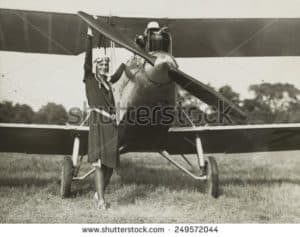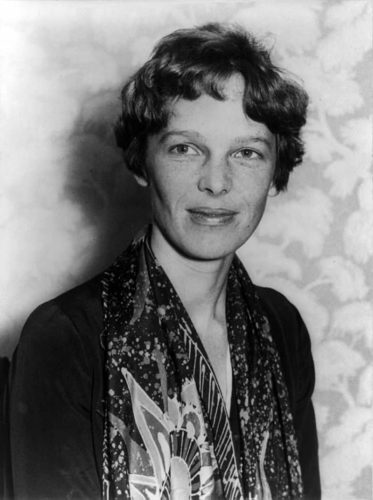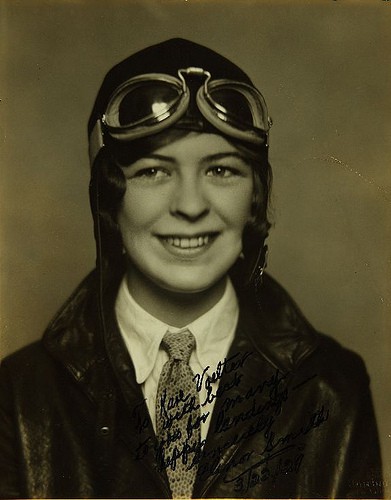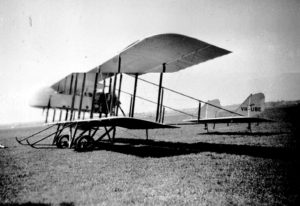Amelia Earhart first became interested in airplanes during World War I when she was a volunteer nurse’s aide at a Canadian military hospital. In 1920, she watched her first airplane exhibition. It took place in Long Beach, California. Amelia’s father arranged a plane ride for her the next day. “By the time I got 200 to 300 feet off the ground, I knew I had to fly,” she said.

Photo Courtesy of Wikimedia Commons
Amelia took flying lessons from a female pilot, Neta Snook. She then bought her first plane and named it “The Canary” because it was painted yellow. After taking stunt flying lessons, Amelia flew in air shows. She broke an altitude world record by flying 14,000 feet high. In 1923, she earned her pilot’s license.

Photo Courtesy of Shutterstock
Charles Lindbergh became the first person to fly solo across the Atlantic Ocean in 1927. Soon, Amelia was asked to become the first woman to fly across the Atlantic. She would be the captain of the flight and keep the flight log. But Amelia would not fly the plane.

Amelia Dressed For Her 1928 Flight
Photo Courtesy of Wikimedia Commons
On June 17, 1928, Amelia, pilot Bill Stultz, and mechanic and co-pilot, Slim Gordon took off from Newfoundland headed for London, England. Their plane, named Friendship, could take off from and land in water.
They flew into fog at 3,000 feet and then into a snowstorm. Bill Stultz flew lower and finally found sunshine. But it didn’t last and again they flew into fog. Unable to see, they radioed ships below asking for their location. Then the radio broke.
When they had only one hour of fuel left, Stulz flew down through the clouds and found a ship. The fliers tried to make contact with the ship, but were unable to. They knew if they landed in the water, Amelia would not be credited with flying across the Atlantic. They continued flying and finally spotted land. It was Burry Port, Wales.
When Amelia returned to America, she was a celebrity. New York City treated her, Bill Stulz, and Slim Gordon to a ticker-tape parade. Amelia wrote a book about the flight titled, 20 Hrs., 40 min.: Our Flight in the Friendship.
Amelia was the first woman to fly across the Atlantic Ocean. But she hadn’t flown the plane. Now Amelia wanted to be the first woman to pilot a plane solo across the Atlantic.

Lockheed Vega
Photo Courtesy of Wikimedia Commons
In 1929, she bought a red Lockheed Vega airplane. She set new speed and altitude records in the Vega. She flew from the East coast to the West coast and back again. In 1932, Amelia was ready to attempt to duplicate the solo flight of Charles Lindbergh.
On May 20, 1932, exactly five years after Lindbergh’s historic flight, Amelia took off in her Vega airplane from Newfoundland. She hoped to reach Paris as Lindbergh had. At first the sky was clear, but then Amelia flew into rain and then ice. She flew lower to melt the ice, but her altimeter had broken. She could no longer tell how high up she was. Amelia had to be very careful not to fly close to the ocean.

Amelia in Northern Island
Photo Courtesy of Shutterstock
When her reserve fuel tank leaked, Amelia abandoned her plans to land in Paris. She looked for land and spotted a pasture. After safely landing, a farmer told her she was in Northern Ireland. The trip took 14 hours and 56 minutes over 2,026 miles. Amelia Earhart was now the first woman to fly solo across the Atlantic Ocean.
If you like this post, then please consider sharing it and making a comment below. Thank you! Barbara Lowell, Children’s Author
You may like:
Books For Kids Amelia Earhart: https://barbaralowell.com/books-for-kids-amelia-earhart/
Harriet Quimby America’s First Female Licensed Pilot https://barbaralowell.com/harriet-quimby-pilot
Barnstorming Bessie Coleman https://barbaralowell.com/barnstorming-bessie-coleman
Elinor Smith Teenage Flying Flapper https://barbaralowell.com/elinor-smith-flying-flapper




